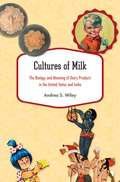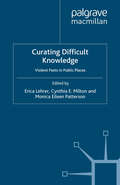- Table View
- List View
Cultures of Computation and Quantification in the Ancient World: Numbers, Measurements, and Operations in Documents from Mesopotamia, China and South Asia (Why the Sciences of the Ancient World Matter #6)
by Karine Chemla Agathe Keller Christine ProustThis book sheds light on the variety of mathematical cultures in general. To do so, it concentrates on cultures of computation and quantification in the ancient world, mainly in ancient China, South Asia, and the Ancient Near East and offers case studies focused on numbers, quantities, and operations, in particular in relation to mathematics as well as administrative and economic activities. The various chapters focus on the different ways and contexts of shaping numbers and quantities, and on the procedures applied to them. The book places special emphasis on the processes of emergence of place-value number systems, evidenced in the three geographical areas under study All these features yield essential elements that will enable historians of mathematics to further capture the diversity of computation practices in their contexts, whereas previous historical approaches have tended to emphasize elements that displayed uniformity within “civilizational” blocks. The book includes editions and translations of texts, some of them published here for the first time, maps, and conventions for editions of ancient texts. It thereby offers primary sources and methodological tools for teaching and learning. The volume is aimed at historians and philosophers of science and mathematics, historians of the ancient worlds, historians of economics, sinologists, indologists, assyriologists, as well as undergraduate, graduate students and teachers in mathematics, the history and philosophy of science and mathematics, and in the history of ancient worlds.
Cultures of Environmentalism: Empirical Studies in Environmental Sociology
by S. YearleyAs environmental issues increasingly impinge on society, sociologists have turned their attention to nature and the environment. However, unlike the majority of sociological work on environmental issues, which has too often been dominated by abstract theoretical disputes, this book concentrates on empirical studies in environmental sociology. It shows what sociologists can bring to current debates over environmental topics (including genetic modification) and - using the author's first-hand research - demonstrates how sociologists can best pursue practical work on environmental topics.
Cultures of Mass Tourism: Doing the Mediterranean in the Age of Banal Mobilities (New Directions in Tourism Analysis)
by Pau Obrador PonsWith more than 230 million international tourists a year, the Mediterranean region is the largest tourist destination in the world. This book outlines that its economic importance is matched by its significance as a cultural and aesthetic phenomenon. Through a series of ethnographic insights into some of the key sites of mass Mediterranean tourism, it focuses on package tourists' experiences of the serial, banal and depthless spaces that are mushrooming along the coast and the enchantments, dissolutions and dreams that saturate them. Moving away from the notion of authentic places corrupted by mass tourism, the book shows how new forms and spaces are made and remade by the mobilities and performances of locals, workers and tourists. Finally, the book looks at the complex materialities of mass tourism and the many networks that make it possible.
Cultures of Mass Tourism: Doing the Mediterranean in the Age of Banal Mobilities (New Directions in Tourism Analysis)
by Pau Obrador PonsWith more than 230 million international tourists a year, the Mediterranean region is the largest tourist destination in the world. This book outlines that its economic importance is matched by its significance as a cultural and aesthetic phenomenon. Through a series of ethnographic insights into some of the key sites of mass Mediterranean tourism, it focuses on package tourists' experiences of the serial, banal and depthless spaces that are mushrooming along the coast and the enchantments, dissolutions and dreams that saturate them. Moving away from the notion of authentic places corrupted by mass tourism, the book shows how new forms and spaces are made and remade by the mobilities and performances of locals, workers and tourists. Finally, the book looks at the complex materialities of mass tourism and the many networks that make it possible.
Cultures of Milk: The Biology And Meaning Of Dairy Products In The United States And India
by Andrea S. WileyAndrea Wiley contrasts the practices of the world's leading milk producers, India and the United States. In both countries, milk is considered to have special qualities. Drawing on ethnographic and scientific studies, popular media, and government reports, she shows that the cultural significance of milk goes well beyond its nutritive value.
Cultures of Milk: The Biology And Meaning Of Dairy Products In The United States And India
by Andrea S. WileyAndrea Wiley contrasts the practices of the world's leading milk producers, India and the United States. In both countries, milk is considered to have special qualities. Drawing on ethnographic and scientific studies, popular media, and government reports, she shows that the cultural significance of milk goes well beyond its nutritive value.
Cultures of Prediction in Atmospheric and Climate Science: Epistemic and Cultural Shifts in Computer-based Modelling and Simulation (Routledge Environmental Humanities)
by Edited by Matthias Heymann Gabriele Gramelsberger Martin MahonyIn recent decades, science has experienced a revolutionary shift. The development and extensive application of computer modelling and simulation has transformed the knowledge‐making practices of scientific fields as diverse as astro‐physics, genetics, robotics and demography. This epistemic transformation has brought with it a simultaneous heightening of political relevance and a renewal of international policy agendas, raising crucial questions about the nature and application of simulation knowledges throughout public policy. Through a diverse range of case studies, spanning over a century of theoretical and practical developments in the atmospheric and environmental sciences, this book argues that computer modelling and simulation have substantially changed scientific and cultural practices and shaped the emergence of novel ‘cultures of prediction’. Making an innovative, interdisciplinary contribution to understanding the impact of computer modelling on research practice, institutional configurations and broader cultures, this volume will be essential reading for anyone interested in the past, present and future of climate change and the environmental sciences.
Cultures of Prediction in Atmospheric and Climate Science: Epistemic and Cultural Shifts in Computer-based Modelling and Simulation (Routledge Environmental Humanities)
by Matthias Heymann Gabriele Gramelsberger Martin MahonyIn recent decades, science has experienced a revolutionary shift. The development and extensive application of computer modelling and simulation has transformed the knowledge‐making practices of scientific fields as diverse as astro‐physics, genetics, robotics and demography. This epistemic transformation has brought with it a simultaneous heightening of political relevance and a renewal of international policy agendas, raising crucial questions about the nature and application of simulation knowledges throughout public policy. Through a diverse range of case studies, spanning over a century of theoretical and practical developments in the atmospheric and environmental sciences, this book argues that computer modelling and simulation have substantially changed scientific and cultural practices and shaped the emergence of novel ‘cultures of prediction’. Making an innovative, interdisciplinary contribution to understanding the impact of computer modelling on research practice, institutional configurations and broader cultures, this volume will be essential reading for anyone interested in the past, present and future of climate change and the environmental sciences.
Cultures of Sustainability and Wellbeing: Theories, Histories and Policies (Routledge Studies in Culture and Sustainable Development)
by Paola Spinozzi Massimiliano MazzantiCultures of Sustainability and Wellbeing: Theories, Histories and Policies examines and assesses the interdependence between sustainability and wellbeing by drawing attention to humans as producers and consumers in a post-human age. Why wellbeing ought to be regarded as essential to sustainable development is explored first from multifocal theoretical perspectives encompassing sociology, literary criticism and socioeconomics, second in relation to institutions and policies, and third with a focus on specific case studies across the world. Wellbeing and its sustainability are defined in terms of biological and cultural diversity; stages of advancement in science and technology; notions of citizenship and agency; geopolitical scenarios and environmental conditions. Wellbeing and sustainability call for enquiries into human capacities in ontological, epistemological and practical terms. A view of sustainability that revolves around material and immaterial wellbeing is based on the assumption that life quality, comfort, happiness, security, safety always posit humans as both recipients and agents. Risk and resilience in contemporary societies define the intrinsically human ability to make and consume, to act and adapt, driving the search for and fruition of wellbeing. How to sustain the dual process of exploitation and regeneration is a task that requires integrated approaches from the sciences and the humanities, jointly tracing a worldwide cartography with clear localisations. This book will be of great interest to students and researchers interested in sustainability through conceptual and empirical approaches including social theory, literary and cultural studies, environmental economics and human ecology, urbanism and cultural geography.
Cultures of Sustainability and Wellbeing: Theories, Histories and Policies (Routledge Studies in Culture and Sustainable Development)
by Paola Spinozzi Massimiliano MazzantiCultures of Sustainability and Wellbeing: Theories, Histories and Policies examines and assesses the interdependence between sustainability and wellbeing by drawing attention to humans as producers and consumers in a post-human age. Why wellbeing ought to be regarded as essential to sustainable development is explored first from multifocal theoretical perspectives encompassing sociology, literary criticism and socioeconomics, second in relation to institutions and policies, and third with a focus on specific case studies across the world. Wellbeing and its sustainability are defined in terms of biological and cultural diversity; stages of advancement in science and technology; notions of citizenship and agency; geopolitical scenarios and environmental conditions. Wellbeing and sustainability call for enquiries into human capacities in ontological, epistemological and practical terms. A view of sustainability that revolves around material and immaterial wellbeing is based on the assumption that life quality, comfort, happiness, security, safety always posit humans as both recipients and agents. Risk and resilience in contemporary societies define the intrinsically human ability to make and consume, to act and adapt, driving the search for and fruition of wellbeing. How to sustain the dual process of exploitation and regeneration is a task that requires integrated approaches from the sciences and the humanities, jointly tracing a worldwide cartography with clear localisations. This book will be of great interest to students and researchers interested in sustainability through conceptual and empirical approaches including social theory, literary and cultural studies, environmental economics and human ecology, urbanism and cultural geography.
Cultures of Wellbeing: Method, Place, Policy
by Sarah C. White Chloe BlackmoreThe authors challenge psychological perspectives on happiness and subjective wellbeing. Highlighting the politics of quantitative and qualitative methodologies, case studies across continents explore wellbeing in relation to health, children and youth, migration, economics, religion, family, land mines, national surveys, and indigenous identities.
Culturing Life: How Cells Became Technologies
by Hannah LandeckerHow did cells make the journey, one we take so much for granted, from their origin in living bodies to something that can be grown and manipulated on artificial media in the laboratory, a substantial biomass living outside a human body, plant, or animal? This is the question at the heart of Hannah Landecker's book. She shows how cell culture changed the way we think about such central questions of the human condition as individuality, hybridity, and even immortality and asks what it means that we can remove cells from the spatial and temporal constraints of the body and "harness them to human intention." Rather than focus on single discrete biotechnologies and their stories--embryonic stem cells, transgenic animals--Landecker documents and explores the wider genre of technique behind artificial forms of cellular life. She traces the lab culture common to all those stories, asking where it came from and what it means to our understanding of life, technology, and the increasingly blurry boundary between them. The technical culture of cells has transformed the meaning of the term "biological," as life becomes disembodied, distributed widely in space and time. Once we have a more specific grasp on how altering biology changes what it is to be biological, Landecker argues, we may be more prepared to answer the social questions that biotechnology is raising.
Culturing microorganisms (large print)
by RnibThis page shows three images showing the procedure of culturing microorganisms. There is a locator dot shown, which will be at the top left, when the image is the correct way up. The top image (1) shows a Bunsen burner on the left with a flame. An inoculating loop is being sterilised in the heat of the flame. It is heated until red hot and then cooled. It must not be put down or blown on. The loop is dipped in a suspension of the bacteria to be grown. The middle image (2) shows the inoculating loop being used on a Petri dish containing agar. It makes a zigzag path across the surface. The last image shows the Petri dish covered with a lid which is taped down and labelled. It is not sealed so oxygen can get in.
Culturing microorganisms (UEB contracted)
by RnibThis page shows three images showing the procedure of culturing microorganisms. There is a locator dot shown, which will be at the top left, when the image is the correct way up. The top image (1) shows a Bunsen burner on the left with a flame. An inoculating loop is being sterilised in the heat of the flame. It is heated until red hot and then cooled. It must not be put down or blown on. The loop is dipped in a suspension of the bacteria to be grown. The middle image (2) shows the inoculating loop being used on a Petri dish containing agar. It makes a zigzag path across the surface. The last image shows the Petri dish covered with a lid which is taped down and labelled. It is not sealed so oxygen can get in.
Culturing microorganisms (UEB uncontracted)
by RnibThis page shows three images showing the procedure of culturing microorganisms. There is a locator dot shown, which will be at the top left, when the image is the correct way up. The top image (1) shows a Bunsen burner on the left with a flame. An inoculating loop is being sterilised in the heat of the flame. It is heated until red hot and then cooled. It must not be put down or blown on. The loop is dipped in a suspension of the bacteria to be grown. The middle image (2) shows the inoculating loop being used on a Petri dish containing agar. It makes a zigzag path across the surface. The last image shows the Petri dish covered with a lid which is taped down and labelled. It is not sealed so oxygen can get in.
Cumulative Effects in Wildlife Management: Impact Mitigation
by Paul R. Krausman Lisa K. HarrisAs humans continue to encroach on wildlands, quality and quantity of wildlife habitat decreases before our eyes. A housing development here, a shopping mall there, a few more trees cut here, another road put in there, each of these diminishes available habitat. Unless the cumulative effects of multiple simultaneous development projects are recogniz
Cumulative Series Index for CRC Handbook of Biochemistry and Molecular Biology: 3rd Edition (Routledge Revivals)
by Gerald D. FasmanFirst Published in 1977, this book serves as a directory for the handbook of biochemistry and molecular biology.
Cumulative Series Index for CRC Handbook of Biochemistry and Molecular Biology: 3rd Edition (Routledge Revivals)
by Gerald D. FasmanFirst Published in 1977, this book serves as a directory for the handbook of biochemistry and molecular biology.
Cumulenes in Click Reactions
by Henri UlrichCumulenes are organic molecules with two or more cumulative (consecutive) double bonds. Their reactions often proceed at room temperature, with or without a catalyst, and are stereospecific, giving the reaction products in high yields – features characteristic of “click reactions”. Cumulenes in Click Reactions presents a comprehensive list of cumulene systems and their reactions, with an emphasis on their “click-like” nature. The chapters are structured according to the number of carbon atoms in the system, including coverage of: introduction to the chemistry of cumulenes one-carbon cumulenes: sulfines, sulfenes, thiocarbonyl S-imides, thiocarbonyl S-sulfides, and 1-aza-2-azoniaallene salts two-carbon cumulenes: carbon oxides, carbon sulfides, carbon nitrides (isocyanates, isothiocyanates, and carbodiimides), phosphaallenes, and diarsaallenes 1,2-dicarbon cumulenes: ketenes, thioketenes, ketenimines, 1-silaallenes, 1-phosphaallenes, and other metal allenes 1,3-dicarbon cumulenes: thiocarbonyl S-ylides, 2-azaallenium salts, 1-oxa-3-azoniabutatriene salts, 1-thia-3-azoniabutatriene salts, and phosphorous ylides 1,2,3-tricarbon cumulenes: allenes, butatrienes, higher cumulenes and heterobutatrienes noncarbon cumulenes: azides, triazaallenium salts, sulfur oxides, sulfur nitrides, N-sulfinylamines, sulfurdiimides, and dithionitronium cation Cumulenes in Click Reactionsis an essential guide for researchers and advanced students in academia and research working in synthetic organic, inorganic and bioorganic chemistry.
The Cunning of Uncertainty (Wiley Desktop Editions Ser.)
by Helga NowotnyUncertainty is interwoven into human existence. It is a powerful incentive in the search for knowledge and an inherent component of scientific research. We have developed many ways of coping with uncertainty. We make promises, manage risks and make predictions to try to clear the mists and predict ahead. But the future is inherently uncertain - and the mist that shrouds our path an inherent part of our journey. The burning question is whether our societies can face up to uncertainty, learn to embrace it and whether we can open up to a constantly evolving future.In this new book, Helga Nowotny shows how research can thrive at the cusp of uncertainty. Science, she argues, can eventually transform uncertainty into certainty, but into certainty which remains always provisional.Uncertainty is never completely static. It is constantly evolving. It encompasses geological time scales and, at the level of human experience, split-second changes as cells divide. Life and death decisions are taken in the blink of the eye, while human interactions with the natural environment may reveal their impact over millennia.Uncertainty is cunning. It appears at unexpected moments, it shuns the straight line, takes the oblique route and sometimes the unexpected short-cut. As we acknowledge the cunning of uncertainty, its threats retreat. We accept that any scientific inquiry must produce results that are provisional and uncertain. This message is vital for politicians and policy-makers: do not be tempted by small, short-term, controllable gains to the exclusion of uncertain, high-gain opportunities.Wide-ranging in its use of examples and enriched by the author’s experience as President of the European Research Council, one of the world’s leading funding organisations for fundamental research. The Cunning of Uncertainty is a must-read for students and scholars of all disciplines, politicians, policy-makers and anyone concerned with the fundamental role of knowledge and science in our societies today.
Cunningham's Textbook of Veterinary Physiology (Sixth Edition) (PDF)
by Bradley KleinLearn how to understand normal body functions before learning about the mechanisms of veterinary disease. The Textbook of Veterinary Physiology, 6th Edition approaches this vast subject in a practical, user-friendly way that helps you grasp key concepts and learn how they relate to clinical practice. From cell physiology to body system function to homeostasis and immune function, this comprehensive text provides the solid foundation needed before advancing in the veterinary curriculum.
Curating Difficult Knowledge: Violent Pasts in Public Places (Palgrave Macmillan Memory Studies)
by Erica Lehrer Cynthia E. Milton Monica Eileen PattersonThis volume inscribes an innovative domain of inquiry, bringing museum and heritage studies to bear on questions of transitional justice, memory and post-conflict reconciliation. As practitioners, artists, curators, activists and academics, the contributors explore the challenges of bearing witness to past conflicts.
Curative and Preventive Properties of Medicinal Plants: Research on Disease Management and Animal Model Studies (Innovations in Plant Science for Better Health: From Soil to Fork)
by Megh R. Goyal Junaid Ahmad Malik Ademola Olabode AyelesoThis book provides scientific reports on the therapeutic potential of medicinal plants using animal models and provides information on the beneficial role of medicinal plants on human diseases. It looks at a number of medicinal plants and examines the medicinal properties and activities of the plants for a variety of health issues, such as for diabetes, cardiovascular disease, neurodegenerative disease, organ dysfunctions, cancer, labor and postpartum issues, and more. The therapeutic mechanisms of some phytoconstituents are also discussed.
Curative and Preventive Properties of Medicinal Plants: Research on Disease Management and Animal Model Studies (Innovations in Plant Science for Better Health: From Soil to Fork)
by Megh R. Goyal Junaid Ahmad Malik Ademola Olabode AyelesoThis book provides scientific reports on the therapeutic potential of medicinal plants using animal models and provides information on the beneficial role of medicinal plants on human diseases. It looks at a number of medicinal plants and examines the medicinal properties and activities of the plants for a variety of health issues, such as for diabetes, cardiovascular disease, neurodegenerative disease, organ dysfunctions, cancer, labor and postpartum issues, and more. The therapeutic mechanisms of some phytoconstituents are also discussed.

















